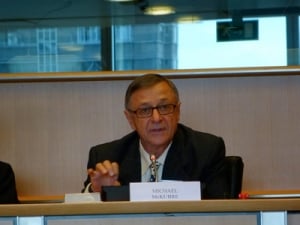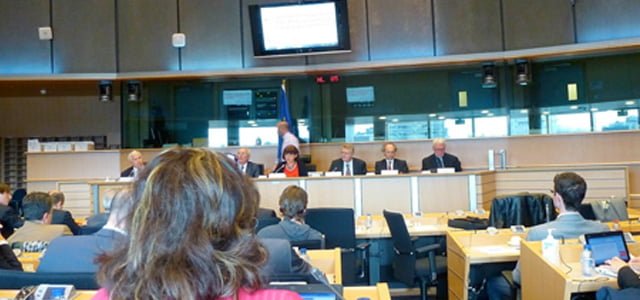 The European Parliament’s Industry, Research and Energy (ITRE) committee chaired by Amalia Sartori met yesterday in Brussels with scientists and business leaders from the new energy community to discuss the status of the Fleischmann-Pons Effect (FPE), the generation of anomalous excess heat from a reaction between hydrogen and various transition metals.
The European Parliament’s Industry, Research and Energy (ITRE) committee chaired by Amalia Sartori met yesterday in Brussels with scientists and business leaders from the new energy community to discuss the status of the Fleischmann-Pons Effect (FPE), the generation of anomalous excess heat from a reaction between hydrogen and various transition metals.
Titled “New advancements on the Fleischmann-Pons Effect: paving the way for a potential new clean renewable energy source?“, the meeting was co-organized by the Italian National Agency for New Technologies, Energy and Sustainable Economic Development (ENEA). An announcement on their website read:
3 June 2013, Brussels. New advancements on the Fleischmann-Pons Effect: paving the way for a potential new clean renewable energy source? Event co-organized by ENEA at the European Parliament. Under the patronage of Hon. Amalia Sartori, Chair of the ITRE Committee c / o European Parliament, the event sees participants between the Commissioner ENEA Giovanni Lelli, the Director of the Industrial Technologies Directorate Herbert Von Bose, the Director of the Sidney Kimmel Institute for Nuclear Renaissance (USA) Graham Hubler, and the Vice-Chancellor for Research, University of Missouri (USA) Robert Duncan.
Daniele Passerini at 22Passi first reported the participants listed as:
Robert Duncan , Vice-Chancellor for Research University of Missouri (USA)
Michael McKubre , SRI – Stanford Research International (USA)
Graham Hubler , Director Sidney Kimmel Institute for Nuclear Renaissance (USA)
Stefano Concezzi , Vice President of National Instruments (USA)
PJ King , CEO ReResearch (Ireland))
Konrad Czerski , University of Szczecin (Poland), Technische Universität Berlin (Germany)
Vittorio Violante , Roma2 Tor Vergata University , Research Centre ENEA Frascati
Andrea Aparo , Roma1 Sapienza University , Politecnico di Milano , Ansaldo Energia
Enrico Paganini , ENEL Green Power
Antonio La Gatta , President TSEM Engineering and Electronics
Giovanni Lelli , Commissioner ENEA
Aldo Pizzuto , Head of Technical Unit Merger ENEA
Maximum Busuoli , Head of EU ENEA – Liaison Office
Herbert von Bose , Director of Industrial Technologies Sub-Commission of the European Parliament
Amalia Sartori , President comission ITRE Committee of the European Parliament
Passerini has posted a report of the meeting which includes photos of slides of several presentations.

Dr. Vittorio Violante, of whom McKubre said “was once the only man in the world who could make palladium that worked”, presented Material Science for Understanding the Fleischmann and Pons Effect. [visit]
Konrad Czerski New Evidence of the Cold Nuclear Fusion – Accelerator Experiments at Very Low Energies. [visit]

Dr. Robert Duncan presented Discovery of New Nuclear Phenomena in Condensed Matter the State. [visit]
Both Hubler and Duncan will be hosting the 18th International Conference on Cold Fusion ICCF-18 this July from their campus at University of Missouri.
According to Passerini, the meeting in Brussels was held “to convince decision makers of the importance of funding research.”
From their website, the ITRE Committee “will deal with legislative proposals on Research; the EU policy on research is due to be redefined for the years to come and to cope with new challenges.”
Ironically, Passerini cites American research as an impetus for the European community, implying targeted support for new energy in the U.S. – were it only true. He also mentions Italy’s official position on cold fusion, which mirror’s the U.S. federal stance: cold fusion is impossible, so let’s ignore it.
Still, Italy has been the heart of new energy research in Europe beginning with Vittorio Violante‘s lab at ENEA focusing on palladium-deuterium cells, and Francesco Piantelli and Sergio Focardi‘s early work on nickel-hydrogen reactions.
Andrea Rossi presented his first public demonstration of the E-Cat steam generator at the University of Bologna in January 2011 which brought the world’s attention to new energy and galvanized a whole community of supporters. Today, an open source project links citizen scientists around the world with longtime researcher Francesco Celani of the Italian Institute for Nuclear Physics (INFN).
ENEA published a report in 2008 on the History of Cold Fusion in Italy [ .pdf] to commemorate the 20th Anniversary of Drs. Martin Fleischmann and Stanley Pons’ announcement of cold fusion which coincided with the 15th International Conference on Cold Fusion held in Rome in 2009.
No doubt there were discussions of the recent report on Rossi’s progress and redesign of the E-Cat HT. The caliber of research presented by both scientists and entrepreneurs could only have impressed the ITRE committee. Positive recommendations to the full Parliament could produce a funding stream for a coordinated research program to hasten the quickening pace of development.

